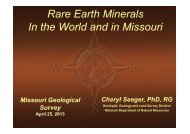Create successful ePaper yourself
Turn your PDF publications into a flip-book with our unique Google optimized e-Paper software.
Wyo-DOG is a multi-tiered application us<strong>in</strong>g a<br />
structured, relational database. Data is entered via<br />
an application us<strong>in</strong>g the traditional client/server<br />
(two-tier) model. Data <strong>in</strong> the relational database<br />
can be queried directly by common model<strong>in</strong>g<br />
applications such as ESRI’s ArcDesktop or via<br />
custom, <strong>in</strong>clud<strong>in</strong>g Web-based, <strong>in</strong>terfaces. Where<br />
appropriate, data can also be made available to<br />
other model<strong>in</strong>g applications through common<br />
data exchange formats, such as CSV and XML, to<br />
facilitate a variety of uses.<br />
Wyo-DOG can be accessed from the WSGS website<br />
at www.wsgs.uwyo.edu/. Wyo-DOG was <strong>in</strong>itiated<br />
with this project to fulfill the goal of creat<strong>in</strong>g<br />
a statewide catalog of REE occurrences, as well as<br />
occurrences of other resources. It is our hope that<br />
adequate resources, <strong>in</strong>clud<strong>in</strong>g fund<strong>in</strong>g, personnel,<br />
and time, will cont<strong>in</strong>ue to be available to further<br />
expand Wyo-DOG to <strong>in</strong>clude new data types,<br />
<strong>in</strong>vestigations, and the many volumes of historical<br />
data that reside <strong>in</strong> paper files at the WSGS.<br />
samples and Analyses<br />
This <strong>in</strong>vestigation is a survey of various sites across<br />
Wyom<strong>in</strong>g based on grab samples (i.e., small, unmeasured<br />
samples, not necessarily representative of<br />
a larger volume of material). Analyses of these grab<br />
samples can neither confirm nor deny the presence<br />
or absence of economic concentrations of REE<br />
or other <strong>elements</strong>. A grab sample only represents<br />
one small piece of evidence for the occurrence of a<br />
m<strong>in</strong>eral concentration or deposit. The grab sample<br />
is not associated with, nor does it <strong>in</strong>dicate a volume<br />
of material greater than the size of the <strong>in</strong>dividual<br />
sample. The elemental concentrations associated<br />
with a grab sample may or may not extend <strong>in</strong>to the<br />
outcrop from which the sample was collected.<br />
A thorough evaluation of a deposit, as opposed to<br />
a survey of occurrences as presented <strong>in</strong> this report,<br />
requires multiple samples be evaluated across<br />
the range of geologic environments that occur at<br />
a specific location. Each of those samples must<br />
represent a specific volume of relatively uniform<br />
material such that elemental concentrations can be<br />
converted to tonnage estimates across the deposit.<br />
Only then can the economic tenor of the deposit<br />
3<br />
be estimated. No s<strong>in</strong>gle sample can def<strong>in</strong>e or elim<strong>in</strong>ate<br />
the possibility of an economic deposit.<br />
Not all samples are equal. The analysis of a panned<br />
concentrate from a placer sample is not equivalent<br />
to that of a grab sample. A panned concentrate results<br />
from wash<strong>in</strong>g disaggregated gra<strong>in</strong>s <strong>in</strong> the field<br />
with water to separate out the heavy ones from<br />
lighter ones. Analytical results may show relatively<br />
high values for some <strong>elements</strong> <strong>in</strong> the concentrate.<br />
However, to provide proper perspective, a panned<br />
concentrate analysis must be diluted to represent<br />
the orig<strong>in</strong>al larger volume of material from which<br />
the concentrate was derived. This dilution may<br />
reduce reported values by a factor of 10 to 100 or<br />
more, depend<strong>in</strong>g on techniques and equipment<br />
used <strong>in</strong> sampl<strong>in</strong>g. Placer samples are appropriately<br />
described <strong>in</strong> both the text of this report and <strong>in</strong><br />
Wyo-DOG.<br />
All sample analyses collected for this project were<br />
completed by ALS Chemex of Reno, Nevada.<br />
Analytical methods for historical samples <strong>in</strong>cluded<br />
with<strong>in</strong> Wyo-DOG or this report are referred to<br />
as generic if either the laboratory or the method<br />
of analysis is not known. Geochemical analyses<br />
on samples <strong>in</strong>cluded whole rock analyses (major<br />
element concentrations <strong>in</strong> the form of oxides) by<br />
<strong>in</strong>ductively coupled plasma (ICP), atomic emission<br />
spectrometry or mass spectrometry, and atomic<br />
adsorption. These methods, when preceded by effective<br />
preparation techniques, can generally detect<br />
most <strong>elements</strong> present <strong>in</strong> a sample from very low<br />
concentrations <strong>in</strong> the range of less than 0.1 to 5<br />
parts per million (ppm) up to ore-grade concentrations.<br />
To put this <strong>in</strong> perspective, 1.0 percent is<br />
equal to 10,000 ppm.<br />
<strong>rare</strong> Earth Elements def<strong>in</strong>ed<br />
Rare <strong>earth</strong> <strong>elements</strong> (a.k.a. <strong>rare</strong> <strong>earth</strong> metals) are<br />
a group of metallic <strong>elements</strong> with similar physical<br />
and chemical properties. Fifteen of these are<br />
listed <strong>in</strong> the periodic table (table 1) <strong>in</strong> a series<br />
from atomic numbers 57 through 71 known as the<br />
lanthanide series. However, one highly-unstable<br />
element, promethium, does not occur naturally on<br />
<strong>earth</strong>, has a half-life of 17.7 years, and decays <strong>in</strong>to



